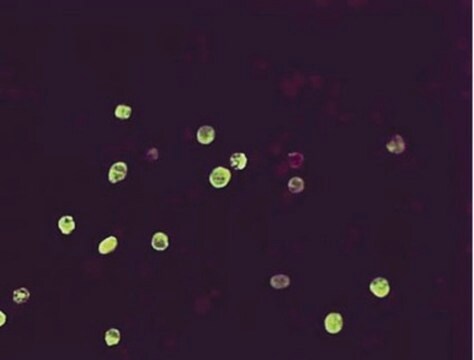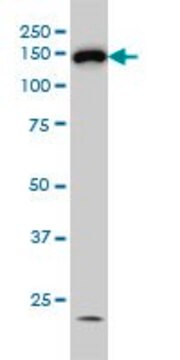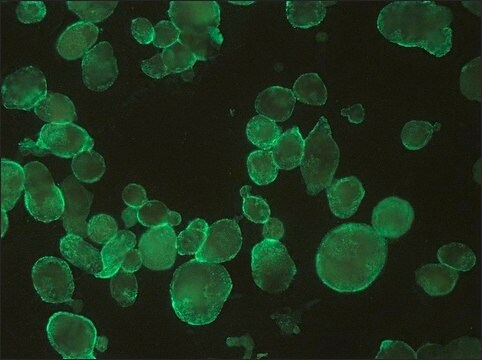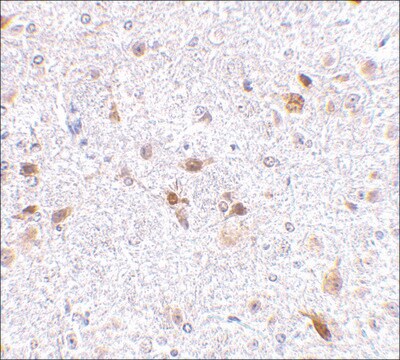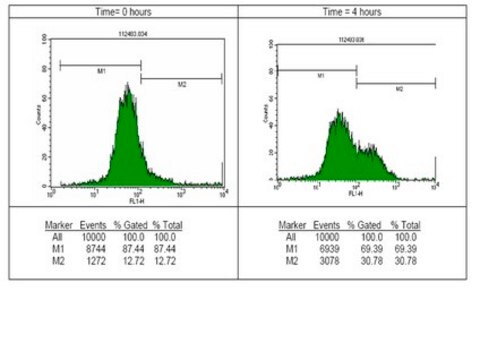MABF1975
Anti-Herpes Simplex Virus Glycoprotein D Antibody, clone LP14
clone LP14, from mouse
Synonym(s):
HSV glycoprotein D
Sign Into View Organizational & Contract Pricing
All Photos(2)
About This Item
UNSPSC Code:
12352203
eCl@ss:
32160702
NACRES:
NA.41
Recommended Products
biological source
mouse
Quality Level
antibody form
purified immunoglobulin
antibody product type
primary antibodies
clone
LP14, monoclonal
species reactivity
virus
species reactivity (predicted by homology)
all
packaging
antibody small pack of 25 μL
technique(s)
immunocytochemistry: suitable
inhibition assay: suitable
western blot: suitable
isotype
IgG2aκ
NCBI accession no.
UniProt accession no.
shipped in
ambient
target post-translational modification
unmodified
General description
Herpes Simplex Virus envelope Glycoprotein D (UniProt: Q69091) is also known as gD. The envelope of herpes simplex virus (HSV) is complex and contains at least 10 virus-encoded glycoproteins, some of which mediate virus entry into the host cell. HSV virus enters the cell by first fusing its envelope with a membrane of the host cell. Five viral envelope glycoproteins are reported to be involved in this entry process. Binding of glycoprotein D of HSV to a cell surface receptor is required to trigger membrane fusion during entry into host cells. Glycoproteins C and B promote attachment by interacting with cell surface proteoglycans and then glycoprotein D binds to the herpes virus entry mediator (HVEM) receptor that initiates a process that ultimately leads to glycoprotein B-mediated membrane fusion. Glycoprotein D is synthesized with a signal peptide (aa 1-25) that is subsequently cleaved off. It is a homodimeric protein that contains two zinc-binding sites (aa 64 and 264). The ectodomain region of glycoprotein D contains three sites for the addition of N-linked oligosaccharides (N-CHO) and six cysteine residues arranged into three disulfide bonds. During virion morphogenesis, glycoprotein D probably accumulates in the endosomes and trans-Golgi where secondary envelopment occurs. (Ref.: Whitbeck JC et al. (1997). J. Virol. 71(8); p. 6083 6093; Nicola, AV et al. (1998). J Virol. 72(5): 3595-3601; Giovine, PD et al. (2011). PLos Pathog. 7(9); e1002277).
Specificity
Clone LP14 detects glycoprotein D of Herpes Simplex virus.
Immunogen
Whole Herpex Simplex Virus 2 (HSV-2).
Application
Anti-Herpes Simplex Virus Glycoprotein D, clone LP14, Cat. No. MABF1975, is a mouse monoclonal antibody that detects Glycoprotein D of Herpes Simplex Virus and has been tested for use in Inhibition, Immunocytochemistry, and Western Blotting.
Research Category
Inflammation & Immunology
Inflammation & Immunology
Western Blotting Analysis: A 1:2,000 dilution from a representative lot detected Herpes Simplex Virus Glycoprotein D in lysates from VERO cells transfected with HSV-1.
Western Blotting Analysis: A representative lot detected Herpes Simplex Virus Glycoprotein D in Western Blotting applications (Lau, S.Y., et. al. (2015). Viruses. 7(3):915-38; Zenner, H.L., et. al. (2011). J Virol. 85(16):8012-21; Pawliczek, T., et. al. (2009). J Virol. 83(21):11254-64).
Western Blotting Analysis: A representative lot detected Herpes Simplex Virus Glycoprotein D in Western Blotting applications (Ren, Y., et. al. (2012). J Gen Virol. 93(Pt 2):319-29).
Immunocytochemistry Analysis: A representative lot detected Herpes Simplex Virus Glycoprotein D in Immunocytochemistry applications (Lau, S.Y., et. al. (2015). Viruses. 7(3):915-38).
Inhibition Analysis: A representative lot inhibited the fusion of cells infected with HSV-1. (Minson, A.C., et. al. (1986). J Gen Virol. 67(6); 1001-1013.
Western Blotting Analysis: A representative lot detected Herpes Simplex Virus Glycoprotein D in Western Blotting applications (Lau, S.Y., et. al. (2015). Viruses. 7(3):915-38; Zenner, H.L., et. al. (2011). J Virol. 85(16):8012-21; Pawliczek, T., et. al. (2009). J Virol. 83(21):11254-64).
Western Blotting Analysis: A representative lot detected Herpes Simplex Virus Glycoprotein D in Western Blotting applications (Ren, Y., et. al. (2012). J Gen Virol. 93(Pt 2):319-29).
Immunocytochemistry Analysis: A representative lot detected Herpes Simplex Virus Glycoprotein D in Immunocytochemistry applications (Lau, S.Y., et. al. (2015). Viruses. 7(3):915-38).
Inhibition Analysis: A representative lot inhibited the fusion of cells infected with HSV-1. (Minson, A.C., et. al. (1986). J Gen Virol. 67(6); 1001-1013.
Quality
Evaluated by Western Blotting in HEK293T cell lysate transfected with HSV gD.
Western Blotting Analysis: A 1:2,000 dilution of this antibody detected Herpes Simplex Virus Glycoprotein D in HEK293T cell lysate transfected with HSV gD.
Western Blotting Analysis: A 1:2,000 dilution of this antibody detected Herpes Simplex Virus Glycoprotein D in HEK293T cell lysate transfected with HSV gD.
Target description
~50 and 55 kDa observed; 43.35 kDa calculated. Uncharacterized bands may be observed in some lysate(s).
Physical form
Format: Purified
Protein G purified
Purified mouse monoclonal antibody IgG2a in PBS without azide.
Storage and Stability
Stable for 1 year at -20°C from date of receipt. Handling Recommendations: Upon receipt and prior to removing the cap, centrifuge the vial and gently mix the solution. Aliquot into microcentrifuge tubes and store at -20°C. Avoid repeated freeze/thaw cycles, which may damage IgG and affect product performance.
Other Notes
Concentration: Please refer to lot specific datasheet.
Disclaimer
Unless otherwise stated in our catalog or other company documentation accompanying the product(s), our products are intended for research use only and are not to be used for any other purpose, which includes but is not limited to, unauthorized commercial uses, in vitro diagnostic uses, ex vivo or in vivo therapeutic uses or any type of consumption or application to humans or animals.
Not finding the right product?
Try our Product Selector Tool.
Certificates of Analysis (COA)
Search for Certificates of Analysis (COA) by entering the products Lot/Batch Number. Lot and Batch Numbers can be found on a product’s label following the words ‘Lot’ or ‘Batch’.
Already Own This Product?
Find documentation for the products that you have recently purchased in the Document Library.
Our team of scientists has experience in all areas of research including Life Science, Material Science, Chemical Synthesis, Chromatography, Analytical and many others.
Contact Technical Service